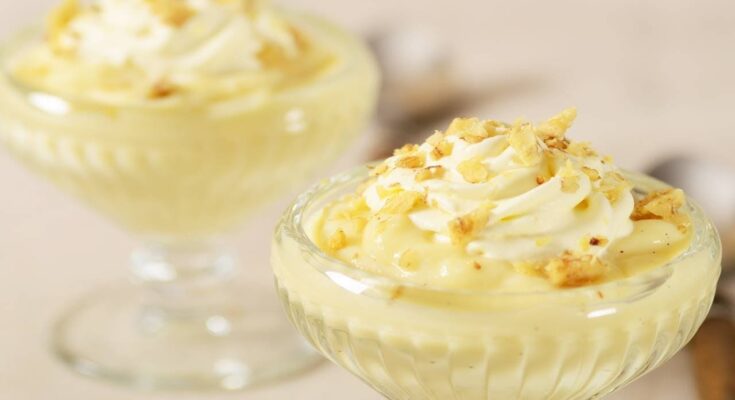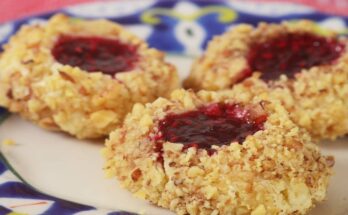Pudding Recipe: There’s something incredibly comforting about a bowl of pudding. Creamy, sweet, and satisfying, pudding is one of those desserts that everyone loves, no matter their age. Whether you’re craving a classic vanilla custard or want to experiment with rich chocolate or fruity flavors, pudding is endlessly versatile. Plus, it’s surprisingly easy to make at home!
In this step-by-step guide, we’ll walk you through everything you need to know to whip up a delectable homemade pudding. Let’s get started!
Types of Pudding
Pudding comes in many forms, ranging from silky smooth custards to hearty bread puddings. Here are some of the most popular types:
- Custard Pudding: Made with eggs, milk, and sugar, it’s the base for many classic recipes like crème brûlée.
- Chocolate Pudding: A decadent option made with cocoa or melted chocolate.
- Bread Pudding: A rustic dessert that uses stale bread soaked in a sweet custard mixture.
- Rice Pudding: Made by simmering rice in milk and sugar, often flavored with cinnamon or vanilla.
- Vegan Pudding: Dairy-free options using almond milk, coconut milk, or other plant-based alternatives.
Each type has its charm, so you can choose based on your cravings or the ingredients you have on hand.
Ingredients Needed for Pudding
The beauty of pudding is its simplicity. Most recipes require just a few pantry staples:
- Milk or Cream: The base of the pudding, providing richness and creaminess.
- Sugar: For sweetness. Granulated, brown, or even alternative sweeteners can be used.
- Thickening Agent: Cornstarch, eggs, or flour, depending on the recipe.
- Flavoring: Vanilla extract, cocoa powder, or spices like cinnamon.
Optional Additions:
- Fruits, nuts, or chocolate chips for added texture.
- Liqueurs like rum or bourbon for an adult twist.
Essential Kitchen Tools
Before diving into the recipe, ensure you have these tools ready:
- Saucepan: For cooking the pudding base.
- Whisk: To mix ingredients smoothly and prevent lumps.
- Measuring Cups and Spoons: Accurate measurements are key.
- Mixing Bowls: For prepping and combining ingredients.
- Sieve or Strainer: Useful for silky smooth pudding.
- Serving Dishes: Small bowls, ramekins, or a large dish for setting the pudding.
Pro Tip: If you don’t have all the tools, don’t worry—improvise! A fork can substitute for a whisk, and any heat-safe dish can serve as your pudding mold.
Step 1: Preparing the Ingredients
Start by gathering and measuring your ingredients. Precision is key in pudding-making to achieve the right consistency. Here’s how:
- Measure Carefully: Use measuring cups and spoons to ensure accuracy, especially for thickening agents like cornstarch or eggs.
- Prep Ingredients: If your recipe calls for eggs, crack them into a separate bowl and whisk gently. For cocoa powder, sift it to avoid lumps.
- Warm the Milk: Gently warming the milk beforehand can prevent curdling and help ingredients combine smoothly.
Taking a few minutes to organize your ingredients makes the rest of the process much smoother.
Step 2: Mixing the Base
The base of your pudding is the foundation of its flavor and texture. Here’s how to get it right:
- Combine Dry Ingredients: In a mixing bowl, whisk together sugar, cornstarch, and cocoa powder (if using). This prevents clumps when the wet ingredients are added.
- Gradually Add Liquid: Slowly pour in the milk, whisking constantly to ensure a smooth mixture.
- Add Flavoring: Stir in vanilla extract or other flavorings for that extra burst of taste.
Pro Tip: If you’re making a custard-based pudding, temper the eggs by adding a small amount of warm milk to them first, then whisking the mixture back into the saucepan. This prevents the eggs from scrambling.
Step 3: Cooking the Pudding Mixture
Now it’s time to cook your pudding:
- Heat Slowly: Pour the mixture into a saucepan and cook over medium heat, stirring constantly.
- Watch for Thickening: As the mixture heats, it will gradually thicken. Don’t rush this step—low and slow is the way to go.
- Avoid Lumps: Keep whisking! This ensures a silky-smooth texture.
- Once the pudding has thickened enough to coat the back of a spoon, you’re ready for the next step.
Step 4: Thickening the Pudding
Getting the right consistency is crucial for pudding. Nobody wants a pudding that’s too runny or one that feels more like a brick. Here’s how to nail the thickening process:
- Monitor the Mixture: As the pudding heats, keep an eye on the texture. You’ll notice it starting to thicken as the cornstarch or eggs work their magic.
- Use the Spoon Test: Dip a spoon into the pudding. If it coats the back of the spoon and holds a line when you run your finger through it, it’s ready.
- Adjust Heat Levels: Keep the heat at medium-low. High heat can cause the mixture to curdle or stick to the bottom of the pan.
- Troubleshooting: If the pudding isn’t thickening, add a small slurry of cornstarch and cold milk, whisking it in gradually. If it’s too thick, a splash of warm milk will fix it.
Patience is key here. A perfectly thickened pudding is smooth, glossy, and spoonable—not gelatinous or watery.
Step 5: Cooling and Setting the Pudding
After thickening, the pudding needs to cool and set to achieve that luscious, creamy texture. Follow these steps:
- Remove from Heat: Once thickened, take the pudding off the stove immediately to prevent overcooking.
- Pour into Dishes: Transfer the hot pudding into individual serving bowls, ramekins, or a large dish.
- Prevent Skin Formation: If you’re not a fan of the skin that forms on top, press a piece of plastic wrap directly onto the surface of the pudding.
- Let it Cool: Allow the pudding to cool at room temperature for about 15-20 minutes before refrigerating.
Place the pudding in the fridge for at least 2-4 hours to set. For best results, let it chill overnight. This time allows the flavors to meld and the texture to firm up perfectly.
Flavor Variations
One of the best things about pudding is how easy it is to customize. Here are some creative flavor ideas to try:
- Chocolate Lovers: Add a handful of dark chocolate chips while the pudding is still warm for extra richness.
- Fruity Flavors: Mix in pureed mango, strawberry, or banana for a refreshing twist.
- Spiced Delights: Infuse the pudding with cinnamon, nutmeg, or cardamom for a warm, cozy vibe.
- Nutty Crunch: Top your pudding with toasted almonds, hazelnuts, or a drizzle of peanut butter.
- Adult-Only: Add a splash of rum, amaretto, or coffee liqueur for a grown-up treat.
Experiment with combinations to find your signature pudding flavor!
How to Serve Pudding
Presentation matters, even for a humble dessert like pudding. Here are some serving tips to make your pudding stand out:
- Temperature: Serve chilled for a classic experience or slightly warm for extra comfort.
- Garnishes: Add whipped cream, fresh fruit, or a sprinkle of cocoa powder for a professional touch.
- Layering: For a fancy look, layer pudding with crushed cookies, granola, or jam in a tall glass to create a parfait.
- Pairings: Serve pudding alongside a crunchy element like biscuits or a slice of cake for contrast.
Whether it’s a simple snack or a showstopper dessert, pudding can be dressed up or down depending on the occasion.
Storing Pudding
Homemade pudding is best enjoyed fresh, but if you have leftovers, here’s how to store it properly:
- Refrigeration: Cover the pudding tightly with plastic wrap or transfer it to an airtight container. Refrigerate for up to 3-4 days.
- Reheating: If you prefer warm pudding, gently heat it in the microwave or over low heat on the stove, stirring frequently.
- Freezing: While not ideal for creamy puddings, bread puddings or rice puddings freeze well. Wrap them tightly and store for up to a month.
Proper storage ensures your pudding stays fresh and delicious, even after a couple of days.
Common Mistakes to Avoid
Pudding is simple, but a few missteps can ruin the result. Here are some common mistakes to avoid:
- Skipping Constant Stirring: Without regular stirring, the pudding can stick to the pan and burn.
- Overheating: High heat can cause the milk to curdle or the eggs to scramble.
- Ignoring Measuring: Eyeballing ingredients can lead to pudding that’s too thick or too runny.
- Rushing the Cooling Process: Pudding needs time to set for the best texture. Don’t skip the chill time!
Avoiding these pitfalls ensures a smooth and satisfying dessert every time.
FAQs about Pudding Recipe
1. What basic ingredients do I need for a pudding recipe?
Most pudding recipes require milk (or a milk substitute), sugar, a thickening agent like cornstarch, eggs, and flavorings such as vanilla extract. Depending on the type of pudding, additional ingredients like chocolate or fruit may be added.
2. Can I make pudding without dairy?
Absolutely! You can substitute dairy milk with plant-based alternatives such as almond milk, coconut milk, or soy milk. Just ensure the alternative milk you choose is unsweetened to control the sweetness of the pudding.
3. How do I prevent lumps in my pudding?
To avoid lumps, mix the cornstarch with a small amount of cold milk until smooth before adding it to the hot mixture. Additionally, constantly stir the pudding as it cooks to help break up any clumps that form.
4. How long does it take to make pudding from scratch?
Making pudding from scratch typically takes about 15 to 20 minutes of cooking time, plus additional time for chilling if you prefer to serve it cold. Ensure you stir the mixture frequently while cooking to achieve a smooth consistency.
5. Can I make pudding ahead of time?
Yes, pudding can be made ahead of time and stored in the refrigerator. It’s actually recommended to let it chill as it helps the pudding to set and develop flavors. Cover it with plastic wrap to avoid a skin from forming on top.
6. How can I thicken my pudding if it’s too runny?
If your pudding is too thin, you can thicken it by cooking it a bit longer while continuously stirring. If it’s still runny, a slurry of cornstarch mixed with cold milk can be added and cooked until the desired thickness is achieved.
7. What are some popular pudding flavors?
Popular pudding flavors include vanilla, chocolate, butterscotch, and banana. Seasonal fruits and spices, like pumpkin or peppermint, are also great for creating flavorful variations.
8. Is pudding gluten-free?
Pudding can be gluten-free if made without any gluten-containing ingredients. Be sure to check labels, especially on store-bought mixes, and use cornstarch or a gluten-free thickener.
9. Can I freeze pudding?
Freezing pudding is possible but may affect the texture, causing it to become slightly grainy when thawed. If you choose to freeze pudding, consume it within a month for best quality.
Conclusion
Making pudding at home is easy, fun, and endlessly rewarding. With just a few basic ingredients and tools, you can create a dessert that’s not only delicious but also completely customizable. From classic vanilla to decadent chocolate or exotic fruity flavors, pudding is a dessert that can be tailored to suit any palate.
So, grab your whisk, experiment with flavors, and enjoy the magic of homemade pudding. Your taste buds will thank you!



